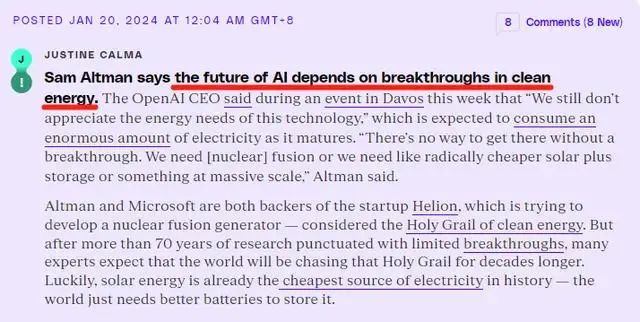Jessie Yao
yaojiaqi@i-battery.com
Anne Xu
xulin@i-battery.com
Albert van Pabst
albert@i-battery.com
Ting
litingting@i-battery.com
Recently, with the rise of artificial intelligence applications such as Sora and ChatGPT, the hot momentum of the AI industry chain has become increasingly obvious. However, at the same time, the industry has found that power consumption has become a new challenge for the development of AI, and AI has gradually become an emerging "power consumer" and "power consumption tiger".
According to an analysis by experts at the University of Pennsylvania, computers account for less than 2% of the world's electricity consumption. However, this figure has risen to 10 per cent and is expected to reach a fifth of global electricity consumption by 2030.
Reports in the US media have noted that ChatGPT's power consumption has caused widespread concern. Currently, ChatGPT may consume up to 500,000 kilowatt-hours of electricity per day, which is equivalent to the electricity consumption of 17,000 American homes. This huge demand for electricity is becoming a huge burden for openAI's location, especially in the context of the already tight electricity supply in the United States.
According to the Artificial Intelligence Index 2023 report by the Stanford Institute for Artificial Intelligence (HAI), OpenAI's GPT-3 consumes up to 1,287 MWH (1 MWH = 1,000 KWH) in a single training session. Guosen Securities estimates that GPT-3 costs $1.4 million for a single training session, while the larger LLM (large language model) training costs between $2 million and $12 million, with 60 percent of the cost being electricity.
Ai companies operate by feeding large amounts of data into models and conducting continuous extensive training. With the further adoption of generative AI technology, its power consumption is expected to increase further. The rapid development of AI may lead to a tighter global energy supply, and our demand for electricity will show a tens of times increase, after all, the future demand for electricity is far more than AI.
Previous
To build a new energy storage system, it is necessary to realize large-scale long-term energy storage as an important direction to overcome in the future
IBTR CEO interviewed by Japanese media: Optimistic about the development prospects of vanadium flow batteries in the Japanese market, and accelerate the layout in Japan
Next
Address: 111 Yehui Road, Wujiang District, Suzhou City, Jiangsu Province, China
Phone: +86 (0512)63953528
Email: Info@i-battery.com
Support Center
Jessie Yao
yaojiaqi@i-battery.com
Anne Xu
xulin@i-battery.com
Albert van Pabst
albert@i-battery.com
Ting
litingting@i-battery.com